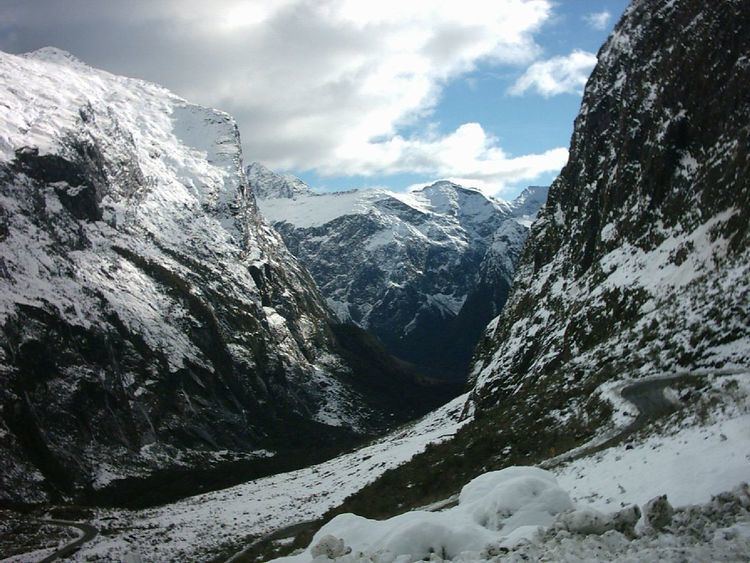 | ||
Tourism is an important industry in New Zealand, directly contributing NZ$7.3 billion (or 3.7%) of the country's GDP in 2013, as well as directly supporting 110,800 full-time equivalent jobs (nearly 6% of New Zealand's workforce). A further 5% of GDP (or NZ$9.8 billion) is indirectly contributed through the flow-on effects of tourism. International tourist spending accounted for 16% of New Zealand's export earnings (nearly NZ$10 billion). International and domestic tourism contributes, in total, NZ$24 billion to New Zealand's economy every year. Currently the Deputy Prime Minister of New Zealand Paula Bennett also serves as Minister of Tourism.
Contents
Map of New Zealand
New Zealand is marketed abroad as a "clean, green" adventure playground (Tourism New Zealand's main marketing slogan, 100% Pure New Zealand, reflects this) with typical destinations being nature areas such as Milford Sound, Abel Tasman National Park or the Tongariro Alpine Crossing, while activities such as bungee jumping or whale watching exemplify typical tourist attractions, often marketed primarily to individual and small-group travellers. By far the highest number of New Zealand's tourists (about 45%) come from Australia due to their close proximity and relations.
The vast majority of tourist arrivals to New Zealand come through Auckland Airport, which handled nearly fifteen million passengers in 2013. Two per cent of visitors arrive by sea (as of 2009). Many international tourists spend time in Auckland, Christchurch, Queenstown, Rotorua, and Wellington. Other high-profile destinations include the Bay of Islands, Waitomo Caves, Aoraki / Mount Cook, and Milford Sound. Many tourists travel large distances through the country during their stays, typically using coach lines or hire cars.
Domestic tourism is also important, though expenditure and trip numbers have been declining or stagnating in the face of fast-growing international tourism. Domestic tourist spending of NZ$9.8 billion a year still exceeds that of international visitors (NZ$6.5 billion).
In November 2012 readers of UK paper The Telegraph voted New Zealand the best country in the world to go to on holiday. The national airline, Air New Zealand, was voted third-best long-haul carrier.
Markets
The top 11 countries for short term visits to New Zealand in terms of their nationality are:
The top five markets (Australia, the People's Republic of China excluding Hong Kong and Macau, the United States of America, Japan and the United Kingdom) provided 71% of New Zealand's overseas visitors, with nearly half of them coming from Australia. Except China and India none of the other Top 10 nationalities require a short term visa for New Zealand.
Overview
The country is internationally seen as a top holiday destination, shown by receiving awards like being voted most favourite destination by the readers of the Condé Nast Traveler magazine (specialising in luxury travels) in 2008, though it slipped to second place in 2009, and was also named the best overseas holiday destination in a 2007 The Daily Telegraph poll, the United Kingdom's largest such poll. Since the start of a 2000 advertising campaign by Tourism New Zealand, there has been a 61% increase in the number of Britons coming to New Zealand.
Tourism New Zealand, the country's official tourism agency, is actively promoting the country as a destination worldwide. Recent activities include a NZ$7 million campaign in China, concentrating on Shanghai, and cooperating to produce a New Zealand tourism layer for Google Earth, the first country to receive such a treatment.
Environmental impacts
Public concern over the environmental impacts of air travel may threaten tourism growth in New Zealand, as almost all tourists fly long distances to reach New Zealand. However, Ministry of Tourism data predicts a four percent annual growth in tourist numbers in New Zealand, with 3.2 million tourists annually to be reached in 2014.
It is however unclear how New Zealand's carbon-neutral policy will affect future tourism – with some researchers arguing that the carbon emissions of tourism are much higher than generally considered, that their offsetting or mitigation will be very difficult, and that this poses a serious threat to the country's major source of foreign income.
Domestic travel
Periodic campaigns are also directed at New Zealanders, urging them to travel within New Zealand instead of overseas, due to a perception by the tourism industry that too many New Zealanders are travelling to Australia or other countries instead of domestically. Perhaps the best known slogan is "Don't leave town until you've seen the country".
Air travel is a popular way of getting around the country due to the lack of transport alternatives over longer distances (for example, going from Auckland to Napier, a 400 km journey, by plane takes an hour, compared to going by car, which takes nearly five hours nonstop or by bus which takes seven hours.) Passenger trains are limited to Auckland-Wellington, Picton-Christchurch and Christchurch-Greymouth, scenic daytrip journeys which often cost more than an airfare. Outside of trunk routes connecting main cities (Auckland, Wellington, Christchurch, Dunedin, Queenstown), airfares can, due to a lack of competition, cost nearly as much as trips to Australia.
Domestic tourism contributed NZ$14 billion to New Zealand's economy (as of the year ended March 2013). 31 million day trips and 16.6 million overnight trips were made in the year ended December 2012, a decline of 4% and 6% respectively. However, total spending stayed static, with a 2% decline in day trip spending (now at $3.7 billion) offset by a 1% increase in overnight spending (currently NZ$6.2 billion).
Tourist activities
Popular tourist activities in New Zealand include sightseeing, adventure tourism, tramping (hiking) and camping. To support active travel, New Zealand has numerous walking and hiking paths (often created and maintained by the DOC), some of which, like the Milford Track, have huge international recognition. There is also a walking route the length of the country, Te Araroa Trail, which is in the process of being finished as of the late 2000s, and a proposed New Zealand Cycleway.
